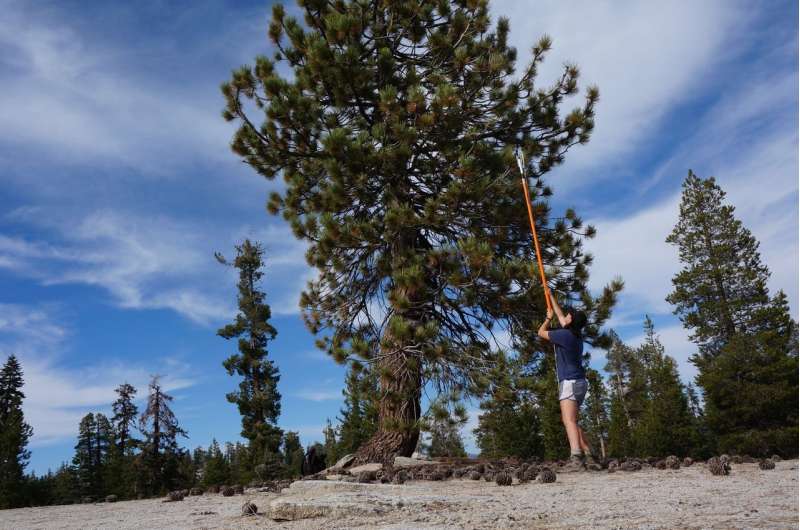Study reveals significant role of dust in mountain ecosystems

Trees growing atop the Bald Mountain Granite in the southern Sierra Nevada rely on nutrients from windblown atmospheric dust—more than 50 percent—compared to nutrients provided from underlying bedrock.
University of Wyoming researchers led a study that found this surprising result by measuring the isotopes of neodymium in the bedrock, soil, dust and pine needles in living trees. Using this well-constrained system, the group was able to combine worldwide data to show that this phenomenon is not limited to the Sierra Nevada, and that foreign dust likely fertilizes plants in many locations worldwide.
"Trees in the Sierra Nevada are using the dust for nutrients," says Cliff Riebe, an associate professor in UW's Department of Geology and Geophysics. "This is a novel finding."
Riebe was second author of a paper, titled "Global Patterns of Dust and Bedrock Nutrient Supply to Montane Ecoystems," which was published today (Dec. 6) in Science Advances, an offspring publication of Science. The online journal publishes significant, innovative original research that advances the frontiers of science and extends the standards of excellence established by Science.
Lindsay Arvin, a UW master's student from Chicago majoring in geology and geophysics, was the paper's lead author. Arvin took samples of live pine needles in the Sierra Nevada, primarily a conifer forest habitat, during summer 2015.
Later that fall, Arvin traveled to Sarah Aciego's laboratory at the University of Michigan, where she worked with Molly Blakowski, a graduate student at the University of Michigan, to process samples. In particular, they were interested in extracting neodymium, an element on the periodic table associated with phosphorus-bearing minerals, which are an important source of plant nutrients.
"The similarity in chemical behavior between neodymium and phosphorus makes neodymium isotopes a useful analog for tracing the uptake of phosphorus in plant systems," says Aciego, now an adjunct professor at UW. "In this case, we were able to trace the neodymium from two sources—foreign dust from Asia and the Central Valley of California, and the granite bedrock."
"We used two fingerprints to trace the nutrients. Dust has one isotopic fingerprint, and bedrock has another isotopic fingerprint," Riebe explains. "Pine needles show the degree of mixing of the two fingerprints. Soils also show a mix of the two."
These observations suggest that dust-derived nutrients can be vital to mountain ecosystems—even when nutrient supply from bedrock is substantial, the paper concludes.
"While other studies have shown that dust can increase total elemental fluxes in ecosystems, this is the first study to quantify the transfer of neodymium and, by proxy, phosphorus, from dust to plants," Aciego explains. "Furthermore, the influence is much higher than I anticipated and suggests that elements in dust could have a much larger impact on global ecosystems than has been previously hypothesized."
Several prior studies have quantified the uptake of dust-derived nutrients in stable or slowly eroding landscapes. But, only a few have quantified dust-derived nutrients in montane ecosystems with substantial erosion rates.
Riebe says his research group took two existing datasets—a global database of erosion rates compiled in 2011 and a global model of dust fluxes created in 2014—to look at the effects of dust worldwide.
"This combination of previous datasets allows us to see where dust is important in the world," Riebe says. "One surprising finding is dust may be more important than previously thought in a lot of places, including the Appalachian Mountains and Western Europe."
"The concept of Earth's 'critical zone' gives us the framework to look at the environment from a larger perspective and to see the global influence of what were thought to be regional processes," says Richard Yuretich, program director for the National Science Foundation (NSF)'s Critical Zone Observatories Program, which funded the study. "This research shows that dust transported in the atmosphere around the world is an important source of nutrients for plants in all environments, even where its contribution isn't obvious. Earth maintains its balance, often in surprising ways."
Riebe sees a connection between his latest research and the five-year, $20 million NSF grant UW received in September to be used for microbial research. Using cutting-edge techniques—including DNA sequencing and computational modeling—scientists hope to learn the distribution and ecological consequences of microbes, producing insights that will help Wyomingites address a variety of challenges—from managing rangeland, forest and water resources, to reclaiming areas disturbed by mineral extraction, to improving crop productivity.
"The microbial communities in dust from different sources can differ," Riebe says. "As part of the next Wyoming EPSCoR (Established Program to Stimulate Competitive Research) program, we can try to understand whether dust from distant sources is affecting Wyoming's microbiome. It could be from the Red Desert or Asia."
More information: L.J. Arvin el al., "Global patterns of dust and bedrock nutrient supply to montane ecosystems," Science Advances (2017). advances.sciencemag.org/content/3/12/eaao1588
Journal information: Science Advances
Provided by University of Wyoming



















